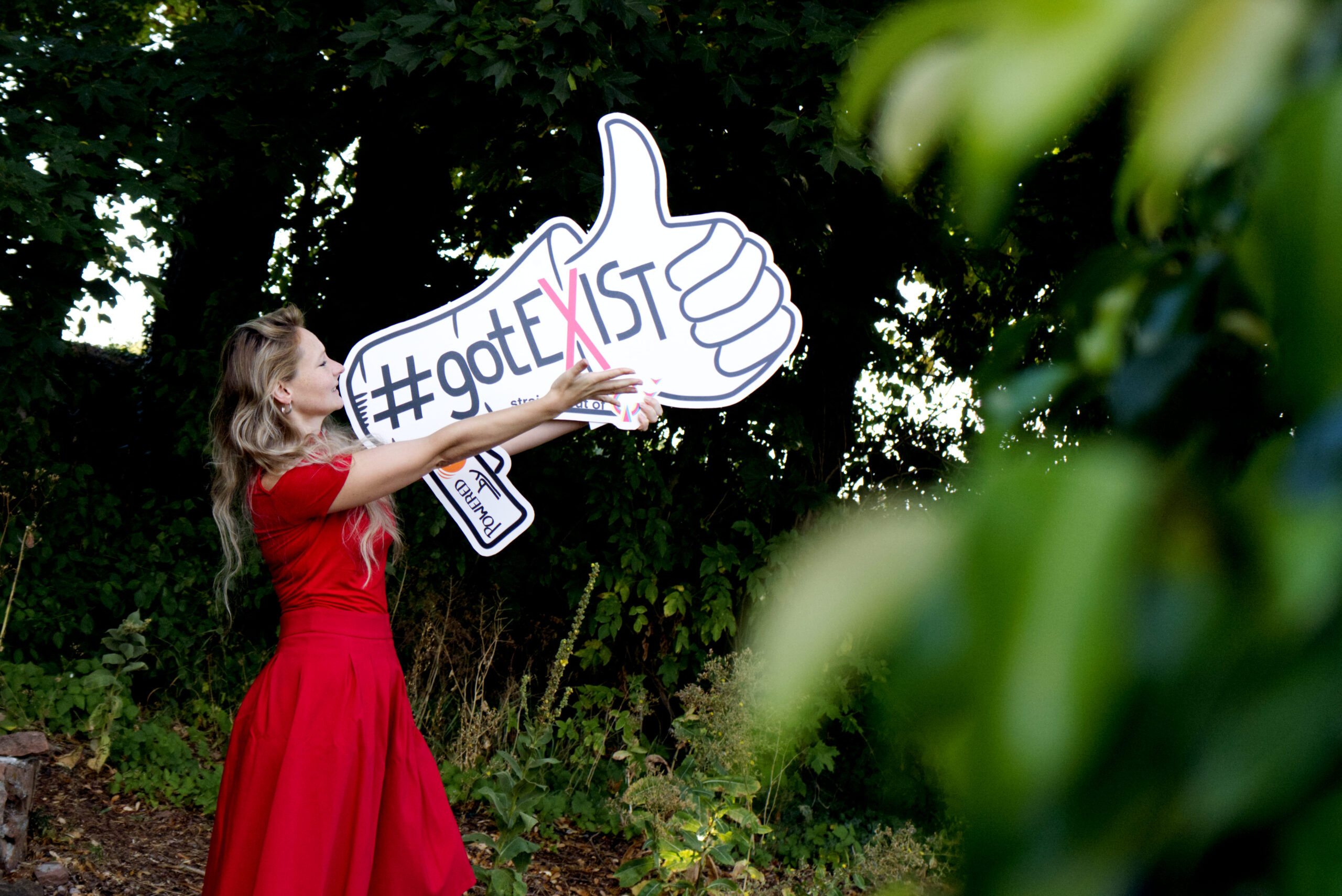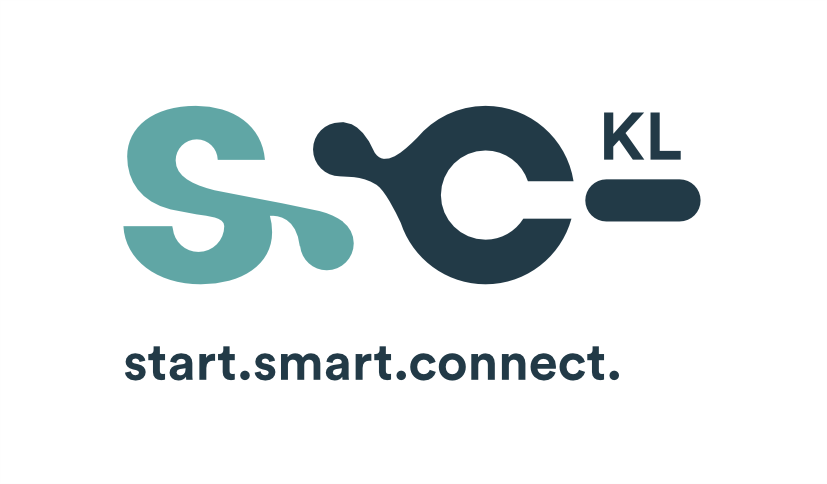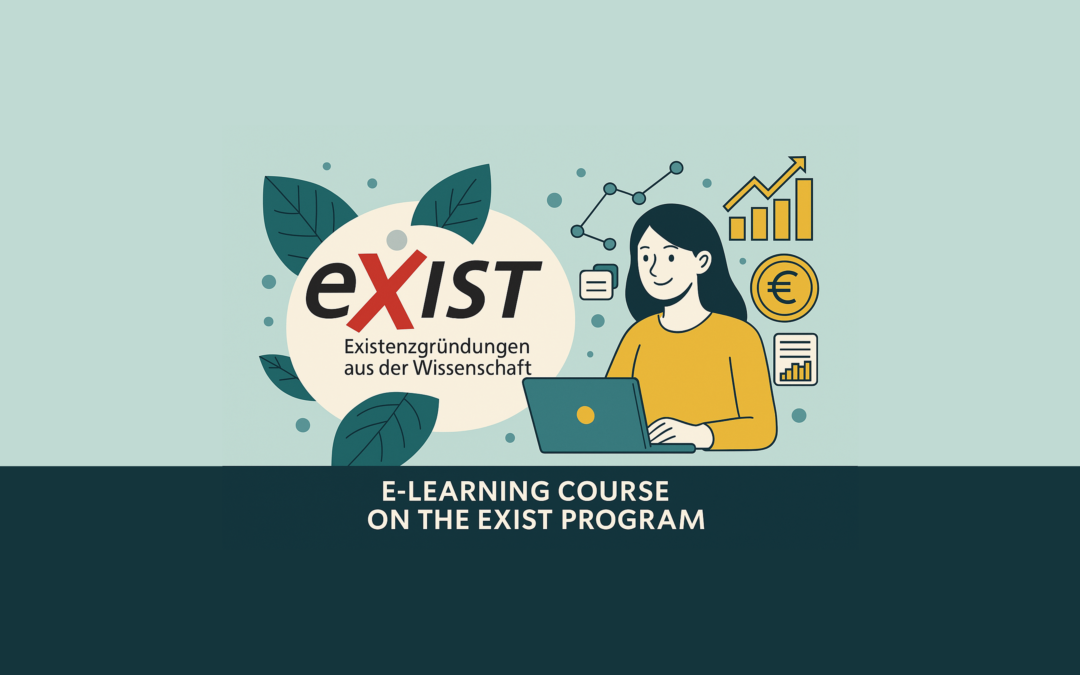EXIST: Supporting Technology and Knowledge-Based Startups in Germany:
EXIST is a programme of the Federal Ministry of Economics and Climate Protection (BMWK). The aim of the programme is to improve the start-up climate at German universities and non-university research institutions. The programme also aims to increase the number and success of technology-based and knowledge-based start-ups. In order to achieve this goal, the BMWK supports university graduates, scientists and students in preparing for a technology-orientated and knowledge-based start-up. EXIST supports you in many ways, the most important support for prospective founders is certainly the EXIST start-up grant and the EXIST research transfer. In this course, you will find out what, who and how funding is provided.
Video 1: EXIST-Researchtransfer
In this video, our EXIST expert Katharina explains all the important information about the EXIST Transfer of Research programme. We ask ourselves the following questions:
📍 What is funded?
📍 Who is funded?
📍 How is funding provided?
📍 Project process
If you want to find out more about EXIST, you can find more information in this course or at www.exist.de. Otherwise, you can also contact Katharina directly at: neitzel@gruendungsbuero.info.
At the bottom of the player you will find an arrow that you can use to open the chapter overview and jump directly to the points of interest to you.
Video 2: EXIST-Scholarship
In this video, our EXIST expert Katharina explains all the important information about the EXIST start-up grant. We ask ourselves the following questions:
📍 What is funded?
📍 Who is funded?
📍 How is funding provided?
📍 Project process
If you want to find out more about EXIST, you can find more information in this course or at www.exist.de. Otherwise, you can also contact Katharina directly at: neitzel@gruendungsbuero.info.
At the bottom of the player you will find an arrow that you can use to open the chapter overview and jump directly to the points of interest to you.
Tips and tricks for a Successful EXIST Grant Application
The EXIST funding program provides a valuable opportunity for academic startups to transform innovative ideas into successful businesses. The EXIST team has conducted nationwide interviews with startup experts to identify key success factors and common mistakes in the application process. These insights can help founders increase their chances of approval.
1. Key Success Factors for an EXIST Grant Application
1.1. Clear Unique Selling Proposition and Market Understanding
- 💡 The uniqueness of the business idea must be clearly defined.
- 🛠️ A functional prototype should be available to demonstrate feasibility.
- 📊 A detailed market analysis is essential: Who are the competitors? What distribution channels exist?
- 📄 The business model should be well-developed, ideally with initial letters of intent (LOI) from potential customers or industry associations.
1.2. Long-Term Business Development and Entrepreneurial Mindset
- 💰 Beyond product development, the long-term financial viability must be convincingly demonstrated.
- 🚀 The team should be genuinely on the path to founding a business—a pure grant-seeking mentality is often viewed critically.
- 👥 A strong team composition is crucial: skills in sales, marketing, business, and product development should be present.
- 🤝 Additional expertise can be covered through a solid network of mentors and industry contacts.
1.3. Preparation Before Submitting the Application
- 🧪 Teams that have already worked together before submitting the application and have undergone initial stress tests have a higher chance of success.
- 📚 The handling of patents at the university should be clarified early on.
- 🏆 Participation in idea competitions and pitch events is beneficial to receive feedback from mentors, entrepreneurs, and investors.
- 🔍 Early evaluation of EXIST funding conditions: Does the project fit the funding criteria? Is it truly innovative?
2. Common Mistakes and Pitfalls
2.1. Issues with Team Composition
- 👨💻 Many teams have an overly homogeneous background (e.g., all are software developers or business graduates).
- ⚠️ Undefined roles within the team can lead to conflicts and delays.
- ⏱️ Adding new team members at the last minute without prior collaboration can be problematic if the chemistry is off.
2.2. Lack of Customer Understanding and Market Fit
- 🗣️ Many founders have not yet spoken with potential customers and risk developing a product that doesn’t meet market demand.
- 🧑💻 The focus is too much on technical development, while go-to-market strategies are neglected.
- 📉 The innovation potential is often overestimated, while market opportunities, competitive advantages, and costs are underestimated.
2.3. Missed Opportunities in Mentorship and Guidance
- ⏳ Teams often seek out a mentor too late, missing valuable guidance.
- 🙈 Startup consulting and customer feedback are not taken seriously enough or are poorly implemented.
2.4. Weak Time and Project Management
- 📅 Lack of planning and commitment leads to unnecessary delays.
- 🗨️ Teams often struggle to clearly communicate their business idea—both as a short pitch (EXIST story) and as a convincing concept paper.
- ✍️ Poor writing and argumentation skills often lead to failed applications.
3. Conclusion: How to Successfully Apply for EXIST
To successfully apply for an EXIST grant, a clear strategy, a strong team, and a realistic market assessment are essential.
- ✅ Focus on a unique selling proposition and market strategy
- ✅ Think about long-term business sustainability
- ✅ Talk to potential customers early and collect LOIs
- ✅ Build a well-balanced team and use external expertise
- ✅ Find mentors early and participate in competitions
- ✅ Write structured, precise application documents with strong arguments
By following these steps, startups can significantly increase their chances of securing EXIST funding and successfully launching their business. 🚀
EXIST-Testimonials
LUBIS-EDA:
Smart IP Generation – Accelerating Microchip Development. As part of the Electronic Design Automation (EDA) industry, we offer an innovative and intelligent approach to generating digital semiconductor IP. By using our software, our customers benefit from a more cost-effective, faster, and error-free microchip development process, leading to a shorter time-to-market.
Inline Process Solutions (IPS):
With the solution from Inline Process Solutions (IPS), you can detect particles, whether tiny droplets or polymorphic crystal collectives, with the highest precision and in real-time. ARIMOS, our innovative optical imaging sensor technology with AI-based analysis software, makes it possible.
Viamon:
Viamon specializes in intelligent security solutions for renewable energy facilities. Using advanced sensor technology and real-time monitoring, the company provides proactive theft prevention for solar farms and other high-value installations. Their cutting-edge solutions integrate seamlessly with security infrastructures to protect assets efficiently and cost-effectively.
Inventied:
Inventied was born from voluntary work in disaster response. Through a research project at the University of Applied Sciences Kaiserslautern in collaboration with the German Federal Agency for Technical Relief (THW), the team developed a prototype for its first product: a modular frame system for trucks and trailers. This system allows THW emergency equipment to be permanently and ergonomically stored for immediate deployment in crisis situations.
From this initial innovation, Inventied developed a three-pillar business model that strengthens disaster response through product development, consulting, and support in public procurement.
Futher informations about EXIST
The official EXIST program website offers comprehensive information for students, graduates, and researchers interested in entrepreneurship. It details funding programs like the EXIST Business Start-up Grant, which supports innovative start-ups. The site provides application guidelines, frequently asked questions (FAQ), and the latest news on entrepreneurship. Additionally, it features success stories offering insights into funded projects. For further information and practical tips, various videos and additional links are available. Visit the website to explore all relevant resources for your entrepreneurial journey.
The EXIST Business Start-up Grant assists you in turning your innovative business idea into reality. It targets students, graduates, and researchers aiming to establish technology-oriented or knowledge-based start-ups. The support includes financial assistance for living expenses, materials, and coaching over a period of up to 12 months. Detailed information on funding conditions, the application process, and helpful tips can be found on the official EXIST website. Utilize this resource to successfully navigate your path to self-employment.
Federal Ministry for Economic Affairs and Climate Protection – EXIST Scholarships
FAQ - Frequently asked questions and further informations
Further informations about EXIST you’ll find here: EXIST-FAQ (in german and english)
EXIST-Startup-Grant Handbook (German): https://exist.de/wp-content/uploads/2025/02/Handbuch-EGT-9-2024.pdf
EXIST-Researchtransfer Handbook (German): https://exist.de/wp-content/uploads/2025/02/Handbuch-EFT-9-2024.pdf
How to EXIST - a step-by-step guide to your concept paper
The most important and time-consuming part of the application for the EXIST Business Start-up Grant is the Idea Paper (Annex 2). This document is used by the reviewers to assess your project’s level of innovation, market potential, and your team. It follows a clear structure, needs a convincing storyline, and should demonstrate your ability to think entrepreneurially.
In the following chapters, we’ll show you what really matters, share useful tips and tricks, and provide a variety of materials to help you craft a strong application for the EXIST Start-up Grant.
NOTE (July 2024): The requirements for the Idea Paper have recently been updated by the project sponsor. This tutorial has not yet been revised — please discuss the changes with your university contacts.
Please go through this video tutorial before sending your Idea Paper to your university startup coach. Use it to double-check whether you’ve covered everything properly.
++++ This can save up to 14 days of processing time. ++++
Keep in mind that each university and startup coach may have their own approach and could offer slightly different advice from what is shown in the tutorial.
Timeline
How long does it take to apply for the EXIST Business Start-up Grant? What steps are involved? How does your university support you in the process?
This tutorial provides an example of the application process — from checking the basic eligibility of your start-up idea to receiving the funding approval from the project management agency.
NOTE (July 2024): The requirements for the idea paper have been changed by the project management agency. This tutorial has not yet been updated — please discuss the current requirements with your university contact.
Business Idea - Startup-story
This chapter shows you how to present the background story of your startup in a way that aligns with the requirements of the EXIST application. The video tutorial highlights the importance of anchoring your project within the university context and provides useful tips on which development milestones are relevant and worth mentioning.
Checklist:
-
Have you described who the originator of the idea is?
-
Have you emphasized how the idea is rooted in science and how the university environment played a role?
-
Have you outlined the steps taken to reach the current stage of development?
NOTE (July 2024): The requirements for the Idea Paper have recently changed. This tutorial has not yet been updated — please consult your university contact to discuss the changes.
Executive Summary
The Executive Summary is usually the first part of your EXIST application that reviewers read — it gives them a quick first impression of your project. That’s why it’s crucial to summarize the three key elements of your Idea Paper in just a few concise paragraphs: Business Idea (problem/solution), Market Fit (market potential/competition/business model), and Team (team members/origin of the idea).
This tutorial explains how to briefly and convincingly summarize the core aspects of your business idea in just two pages.
Checklist:
-
Are all building blocks covered?
-
Is everything formulated as briefly and concisely as possible?
-
Are the contents clearly formulated?
-
Have you used numbers, data, facts, and references to support your argument?
-
Have you considered your quick wins?
-
Do you make it clear in the first 30 seconds what the reviewers want to know?
NOTE (July 2024): The requirements for the Idea Paper have recently changed. This tutorial has not yet been updated — please check in with your university contact to clarify the changes.
Business Idea - Innovation
The EXIST Business Start-up Grant supports innovative business ideas. In this video tutorial, you’ll learn what counts as innovation within the EXIST program and how to best describe your product or service offering.
Checklist:
-
-
Did you start the chapter by describing the problem or need your offering addresses?
-
Did you go into detail in your product/service description, and is it understandable for the reviewers?
-
Have you clearly stated how the (technological) innovation compares to the current state of the art?
-
Did you include illustrations?
-
Have you addressed the topic of intellectual property?
-
NOTE (July 2024): The requirements for the Idea Paper have recently changed. This tutorial has not yet been updated — please check with your university contact to discuss the changes.
Business Idea - Experts
A key part of the application is the presentation of the scholarship team, including its scientific and technical expertise, industry knowledge, entrepreneurial skills, and relevant practical experience. The tutorial emphasizes the importance of having a diverse team with complementary strengths. It also provides guidance on how to address potential skill gaps within the team.
Checklist:
-
-
Have you differentiated between the core team (grantees) and the extended team (supporters, mentors, etc.)?
-
Are your technical and practical skills presented?
-
Have you clearly defined the distribution of responsibilities?
-
Did you include a team photo in the application?
-
Have you highlighted diversity dimensions present in your team?
-
NOTE (July 2024): The requirements for the Idea Paper have recently changed. This tutorial has not yet been updated — please discuss the changes with your university contact.
Sustainability
Sustainability is a relevant aspect in the EXIST application, as the project sponsor considers it a key factor for long-term start-up success. This tutorial shows how your business idea can align with the sustainability goals of the German Federal Government and the ESF cross-cutting objectives. The focus is on gender equality, equal opportunities and non-discrimination, as well as environmental sustainability.
Checklist:
-
-
Are there aspects of the German government’s sustainability goals that relate to your business idea?
-
Does your team make a significant contribution to the ESF cross-sectional goals?
-
Was the maximum length (1 page) respected?
-
Avoid personal interpretations, political opinions, or forced connections to a sustainability goal.
-
Did you use the provided web links as guidance?
-
NOTE (July 2024): The requirements for the Idea Paper have recently changed. This tutorial has not yet been updated — please discuss the changes with your university contact.
Business Idea - project planning
In this chapter, you’ll learn how to create a meaningful project plan for your start-up. The video tutorial explains which elements a solid project plan should include and gives useful tips on the formal requirements when drafting it.
Checklist:
-
-
Are the relevant milestones categorized by functional area?
-
Is the duration of individual work packages shown?
-
Are the responsibilities for each work package clear?
-
Are all tasks assigned evenly among team members?
-
Did you present the project plan both visually and in text?
-
Do you provide a perspective on what will happen after the EXIST funding ends?
-
NOTE (July 2024): The requirements for the Idea Paper have recently changed. This tutorial has not yet been updated — please talk to your university contact to clarify the changes.
Market - market situation
In this chapter, you’ll demonstrate that you understand your target market and can assess its key dynamics. A solid market analysis includes aspects such as market growth, market potential, segmentation, and market volume.
The market potential is best described using the TAM-SAM-SOM model. Segmenting the market helps you break down the overall market of your business idea into specific groups. The market volume gives an indication of the current revenue generated by a particular product category within a defined customer group.
Checklist:
-
-
Did you use reliable data, the bottom-up or top-down method to assess the target market?
-
Did you consider trends and current data?
-
Did you use tools such as the TAM-SAM-SOM model to describe market potential?
-
For niche markets, did you divide the total market into segments?
-
Did you answer the questions Who? Where? How much? when calculating market volume?
-
NOTE (July 2024): The requirements for the Idea Paper have recently changed. This tutorial has not yet been updated — please talk to your university contact to clarify the changes.
Market - Unique Selling Point and Value Proposition
Part 1: Basics
Customer value is closely linked to your unique selling proposition — it defines how useful your product or service is to your customers and what kind of value it delivers to them. In this section, you’ll explore the basic value, additional benefits, and added value your offering provides, and identify the different types of customer value you create.
The Value Proposition Canvas can help you structure and refine your value proposition effectively.
Checklist:
-
-
What is your customer benefit?
-
What basic, additional, or unique value does your product or service offer?
-
What type of customer value do you provide?
-
NOTE (July 2024): The requirements for the Idea Paper have recently changed. This tutorial has not yet been updated — please discuss the changes with your university contact.
Part 2: Value Proposition
What is the target group’s problem, and what solution can you offer that sets you apart from the competition and provides added value for the customer?
Checklist:
-
-
What problem do you solve for whom?
-
Why do you solve the problem differently than competitors?
-
What is your unique selling point?
-
What value do you create?
-
Does your product create added value?
-
Were your problem hypotheses thoroughly validated with customers (e.g., interactive MVP development)? —> Name implementation and process.
-
Is your problem clear and well-defined?
-
Can the customer problem and solution be explained in 1–2 sentences?
-
Did you use a Value Proposition Canvas or similar tool?
-
Was your product compared with potential competitors and were differences worked out?
-
Market - Competitors
How can you effectively analyze your competition and integrate it into your EXIST application? This tutorial explains who your competitors are and what exactly you’re competing for. It also helps you identify the best tools to visualize your competitive landscape and clearly highlight your unique value compared to others in the market.
Checklist:
-
-
Were all dimensions of competition considered?
-
Is competition visually represented (e.g., Porter’s 5 Forces or Spider Web Diagram)?
-
Is your benefit shown in comparison to the competition (e.g., matrix)?
-
Did you also consider indirect competitors?
-
In what aspects are you better than your competitors?
-
NOTE (July 2024): The requirements for the Idea Paper have recently changed. This tutorial has not yet been updated — please check in with your university contact to discuss the changes.
Market - Market entry
In the previous chapters, you have already described the market and estimated its size. The Market Entry chapter focuses on the question of how you plan to enter and capture your market. Identify your target groups and potential customers, and outline the operational and strategic marketing and sales activities you intend to implement. You’ll also learn how detailed your description of market entry barriers should be and how strategic partnerships can support a successful entry.
Checklist:
-
-
Did you specify, prioritize, and link your target groups to customer problems?
-
Are marketing and sales measures described strategically and operationally?
-
Do you already have pilot customers, and what role do they play in your market entry?
-
What are your market entry barriers?
-
Are there strategic partnerships for market entry?
-
Is the structure clear, understandable, and appropriate? See formal aspects.
-
Did you ensure potential sources of error are avoided?
-
Did you check and apply the linked tips & tricks?
-
Use “Letters of Intent” as proof of cooperation and pilot customers.
-
NOTE (July 2024): The requirements for the Idea Paper have recently changed. This tutorial has not yet been updated — please discuss the changes with your university contact.
Market - Letter of Intent (LOI)
What is a Letter of Intent (LOI) and why is it important for your EXIST application? Through an LOI, partners confirm why they find your project valuable and how they plan to support the implementation of your startup idea. These letters serve as both a decision-making aid and a form of validation for reviewers assessing your application.
LOIs are especially relevant for the Market Entry chapter (e.g., pilot customers) and should be included as an annex to the Idea Paper.
Checklist:
-
-
Consider early on which stakeholders would be suitable LOI partners.
-
Check your own network: who is already a partner or supporter that could be an LOI partner?
-
Consider drafting the LOI text for your partner.
-
Did you show the draft/text of the LOI to the university startup coach for feedback?
-
Were all existing LOIs scanned and emailed to the startup coach?
-
NOTE (July 2024): The requirements for the Idea Paper have recently changed. This tutorial has not yet been updated — please discuss the changes with your university contact.
Company - Financial planning
Financial planning helps you estimate the costs and efforts involved in building your startup and define how you plan to finance them. You’ll need to determine the pricing model for your products or services and assess your break-even point. Additionally, your financial plan should outline all expected revenues and expenses, and show how follow-up funding can help ensure the long-term success of your business.
Checklist:
-
-
Has the pricing model been determined?
-
Is the break-even point calculated?
-
Has a tabular financial plan including milestones been created?
-
Have you avoided common mistakes and followed all tips & tricks?
-
Company - Corporate Organization
This chapter provides an overview of your business structure, possible legal forms, and your team and staffing plans.
Checklist:
-
-
Do you know your individual skills, as well as your capacity and knowledge limits?
-
Did you seek professional advice when choosing your legal form, and can you justify your choice entrepreneurially?
-
Is your team diverse? Think of ESF cross-sectional goals!
-
Could a spin-off exclude certain funding opportunities?
-
NOTE (July 2024): The requirements for the Idea Paper have recently changed. This tutorial has not yet been updated — please discuss the changes with your university contact.
Company - Chances and Risks
This tutorial explains how to use a SWOT analysis to identify strengths and weaknesses, as well as opportunities and risks — helping you to shape a successful business strategy.
Checklist:
-
-
Were actions derived from the SWOT analysis, prioritized, and implemented?
-
Did you focus especially on your risks and weaknesses? Strengths and weaknesses are internal factors and within your control!
-
NOTE (July 2024): The requirements for the Idea Paper have recently changed. This tutorial has not yet been updated — please consult your university contact to discuss the changes.

Hi, i'm Lukas
and I manage the e-learning program. Do you have any further questions? Feel free to contact me via email: theisen@gruendungsbuero.info

Hi, i'm Katharina
and I am responsible for our EXIST applications. Do you have any questions? Then please contact me directly at: neitzel@gruendungsbuero.info

